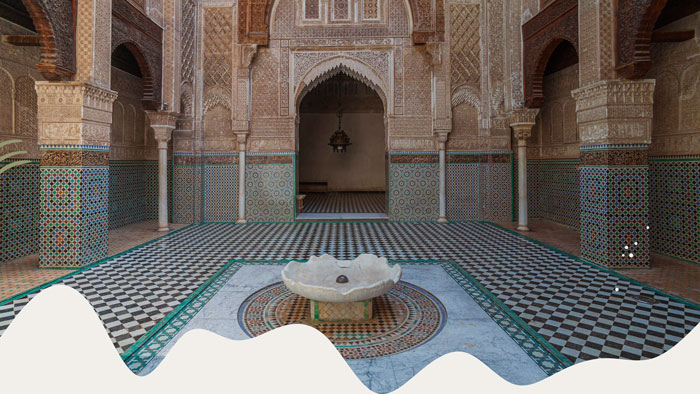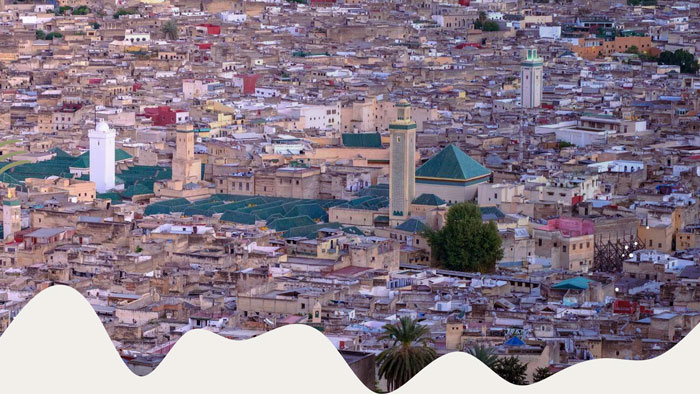
The Story of Morocco’s Oldest Universities and Libraries
Morocco’s rich history is not only reflected in its stunning architecture and vibrant culture but also in its long-standing tradition of education and scholarship. Among the many treasures of the country, its oldest universities and libraries stand out as living testaments to centuries of intellectual pursuit. At the heart of this legacy is the University of Al Quaraouiyine in Fez, founded in 859 AD by Fatima al-Fihri, recognized as the world’s oldest existing degree-granting university.
These historic institutions were more than places of learning—they were centers for cultural exchange, scientific discovery, and spiritual growth. From ancient manuscripts on theology, astronomy, and medicine to the training of scholars who shaped intellectual thought across the Islamic world, Morocco’s oldest universities and libraries played a pivotal role in preserving knowledge for generations.
In this article, we will explore the fascinating story behind Morocco’s oldest universities and libraries, uncovering their history, significance, and the treasures they still hold today. Whether you are a history enthusiast, a traveler seeking unique cultural experiences, or a curious reader, this journey through Morocco’s centers of learning promises insights into a rich and enduring intellectual heritage.
Morocco’s Historical Context in Education
The story of Morocco’s oldest universities and libraries is not only a national treasure but also a cornerstone of global intellectual history. These institutions are among the oldest universities and libraries in the world, with origins dating back over a millennium, and they played a crucial role in shaping learning, science, and culture across the Islamic world and Europe.
Education in Morocco began with Quranic schools, or madrasas, which focused on religious instruction and the memorization of the Quran. Over time, these centers of learning expanded their curriculum to include theology, Islamic law, philosophy, mathematics, astronomy, medicine, and even music and poetry, offering a remarkably broad education for their time. This comprehensive approach allowed Moroccan scholars to contribute significantly to global knowledge, influencing academic and scientific developments far beyond the country’s borders.
During the Almoravid (11th–12th centuries) and Almohad (12th–13th centuries) dynasties, Morocco became a hub of international scholarship. The rulers of these eras recognized the value of knowledge as a pillar of society, building universities, libraries, and madrasas that attracted scholars from North Africa, Spain, the Middle East, and beyond. Fez, Marrakech, and Meknes flourished as vibrant centers of intellectual exchange, where debates, manuscript copying, and research were daily practices.
The Marinid dynasty (13th–15th centuries) further strengthened this tradition by founding new madrasas and expanding library collections, preserving rare manuscripts on medicine, astronomy, mathematics, and law. These institutions were not only repositories of knowledge but also active centers of scholarship where students and teachers collaborated, debated, and advanced human understanding.
Trade routes, religious pilgrimage, and cultural exchange amplified Morocco’s influence. Scholars traveling to study or teach carried manuscripts and ideas across continents, establishing Morocco as a key node in the global network of knowledge during the medieval period.
Understanding this rich history shows why Morocco’s oldest universities and libraries are celebrated not just within the country but globally. They represent some of the world’s oldest continuous centers of higher learning, preserving knowledge that shaped civilizations and continues to inspire scholars today.
The Oldest Universities in Morocco and the World
When discussing Morocco’s oldest universities and libraries, one institution consistently stands out: the University of Al Quaraouiyine in Fez. Founded in 859 AD by Fatima al-Fihri, the daughter of a wealthy merchant, Al Quaraouiyine is widely recognized as the world’s oldest continuously operating university. Unlike many modern universities, it grew organically from a religious madrasa attached to a mosque into a vibrant intellectual center that shaped global scholarship.

Curriculum and Learning Environment
Al Quaraouiyine offered an extensive curriculum that went far beyond religious studies. While students studied Islamic theology and law, they also engaged deeply with astronomy, mathematics, medicine, grammar, rhetoric, logic, and philosophy. The teaching methods were rigorous: students participated in oral debates, memorization exercises, and practical applications of knowledge. Scholars wrote and copied manuscripts, preserving texts that might otherwise have been lost to time.
The university also fostered a dynamic scholarly community. Students lived in close quarters, sharing knowledge and engaging in intellectual discussions that often lasted late into the night. This environment created a cross-cultural exchange, as scholars from Spain, North Africa, the Middle East, and even Europe came to study and teach.
Famous Alumni and Scholars
Al Quaraouiyine’s alumni list reads like a “who’s who” of medieval intellectual history:
-
Maimonides (1135–1204): The Jewish philosopher and physician studied here, absorbing Islamic scholarship that later influenced his writings.
-
Abu Bakr ibn al-Arabi (1076–1148): One of the most respected Islamic jurists and scholars in North Africa.
-
Ibn Khaldun (1332–1406): Although he studied at several institutions, his early education was shaped by Moroccan universities, contributing to his revolutionary ideas in sociology and history.
Other Historic Moroccan Universities
While Al Quaraouiyine is the most famous, Morocco was home to several other significant institutions:
-
University of Al-Attarine (Fez): Founded during the Marinid dynasty, it became a center for theology and law.
-
Madrasa of Ben Youssef (Marrakech): Known for its beautiful architecture and rigorous study of religious sciences.
-
Meknes and Salé Madrasas: Produced scholars who would go on to teach across North Africa and Andalusia.
Global Significance
These universities were not isolated centers of learning. They acted as hubs of global knowledge, linking Morocco to intellectual movements in the Islamic world and Europe. Manuscripts produced and preserved here influenced the translation movements in Spain, Italy, and beyond, laying the foundations for modern science, philosophy, and medicine.
In essence, Morocco’s oldest universities and libraries are not only national treasures but monuments of world education. They demonstrate Morocco’s pivotal role in shaping global intellectual history, serving as centers where knowledge was created, preserved, and transmitted across centuries.
Morocco’s Historic Libraries
Morocco’s universities owe much of their influence to their historic libraries, which have preserved centuries of knowledge and rare manuscripts that continue to fascinate scholars today. Many of these manuscripts are unique and invaluable, containing works on theology, science, medicine, and philosophy. They reflect Morocco’s longstanding dedication to education and the preservation of culture. Some of these libraries are considered among the oldest in the world, with origins dating back over a thousand years. They were more than mere repositories—they served as centers for learning, debate, and intellectual exchange, attracting scholars from across Africa, the Middle East, and Europe. Libraries such as Al Quaraouiyine Library safeguarded manuscripts that influenced global knowledge and education. Today, many of these libraries continue to be living centers of study and cultural heritage, where the wisdom of past generations remains accessible. Together, Morocco’s universities and libraries form a timeless legacy of intellectual achievement, offering insight into the country’s pivotal role in the history of learning.

Al Quaraouiyine Library: A Living Treasure
At the heart of Morocco’s intellectual heritage is the Al Quaraouiyine Library, founded alongside the University of Al Quaraouiyine in 859 AD. Initially, it served as a collection for religious texts, but over centuries it expanded to house manuscripts on science, astronomy, mathematics, medicine, philosophy, literature, and law.
The library’s manuscripts are unique for several reasons:
-
Many are written on ancient parchment or hand-made paper.
-
They include original commentaries by prominent scholars.
-
The collection preserves texts in Arabic, Berber, and even Latin, reflecting centuries of cross-cultural exchange.
In recent years, the library underwent careful restoration, reopening to the public while ensuring the preservation of fragile manuscripts. Some of the oldest texts are over 1,000 years old, making this library a living connection to the medieval world.
Other Notable Libraries
Beyond Al Quaraouiyine, Morocco is home to several other historic libraries and manuscript collections:
-
Zaouia Libraries: Religious and spiritual centers in Fez, Marrakech, and other cities that safeguarded thousands of manuscripts on theology, law, and philosophy.
-
Private Collections: Wealthy scholars and families preserved rare texts, ensuring their survival through centuries of political and social change.
-
National Library of the Kingdom of Morocco (Rabat): While modern, it continues the legacy by collecting, preserving, and digitizing historic manuscripts for future generations.
Manuscripts and Their Global Significance
The manuscripts found in these libraries are more than historical curiosities—they are windows into the intellectual achievements of medieval Morocco and the broader Islamic world. Scholars here made groundbreaking contributions to:
-
Astronomy: Detailed observations that informed navigation and calendar-making.
-
Medicine: Medical texts that predated similar European works.
-
Mathematics and Geometry: Advanced studies influencing later scholars in Europe.
-
Philosophy and Literature: Preserved translations and commentaries that bridged Islamic and European thought.
Preservation and Modern Access
Today, Morocco’s historic libraries are not only cultural treasures but also active centers for research and tourism. Many manuscripts are being digitized, allowing scholars worldwide to access texts that were once hidden in Morocco’s medinas. Visiting these libraries offers a rare glimpse into the birthplace of some of the world’s oldest continuous intellectual traditions.
In short, the libraries of Morocco are inseparable from its universities—they are the guardians of knowledge, maintaining a living link between the past and the present, and illustrating why Morocco’s educational heritage remains globally significant.
Explore Morocco’s Intellectual Treasures
Morocco’s Legacy in Learning and Preservation
The story of Morocco’s oldest universities and libraries is not just a tale of buildings or manuscripts—it is a story of enduring intellectual influence and cultural preservation. For over a millennium, Morocco has been a bridge between civilizations, transmitting knowledge across continents and ensuring that the wisdom of the past remains alive today.
Global Influence of Moroccan Scholarship
Moroccan scholars were not confined to their cities—they traveled extensively across North Africa, the Middle East, and Europe. The University of Al Quaraouiyine alone produced scholars who contributed to Islamic jurisprudence, philosophy, medicine, and science. Their works were copied, studied, and referenced in countries as far away as Spain, Italy, and Egypt, making Morocco a key player in the medieval global knowledge network.
Manuscripts preserved in Moroccan libraries informed early European universities and influenced the translation movements in Andalusia, where Arabic texts were translated into Latin and contributed to the European Renaissance. Morocco’s educational institutions, therefore, were pioneers in knowledge preservation and dissemination, impacting generations of thinkers worldwide.
Preservation Efforts in the Modern Era
Recognizing the historical importance of these institutions, Morocco has undertaken significant efforts to restore and protect its universities and libraries:
- Al Quaraouiyine Library underwent extensive restoration, preserving manuscripts over a thousand years old.
- Digital initiatives now allow scholars worldwide to access Morocco’s rare texts, bridging past and present.
- Training programs for librarians and conservators ensure that fragile manuscripts and historical documents are properly maintained.
Continuity of Intellectual Tradition
Even today, Morocco’s universities continue to foster learning and scholarship. Modern Moroccan institutions honor the traditions of rigorous study, cross-cultural exchange, and manuscript preservation. This continuity ensures that Morocco’s intellectual heritage is not a relic of the past, but a living, evolving legacy.
By understanding Morocco’s commitment to education and preservation, we can see why its universities and libraries are not only national treasures but also worldwide symbols of intellectual achievement. They remind us that knowledge is a bridge across time and space, and that Morocco’s contributions to global learning continue to resonate centuries after their founding.
Visiting Morocco’s Educational Heritage
For travelers and history enthusiasts, Morocco offers a unique opportunity to walk in the footsteps of scholars who shaped global knowledge. Visiting the country’s oldest universities and libraries provides not only a glimpse into architectural beauty but also a direct connection to a millennium of intellectual history.
Fez: The Heart of Moroccan Scholarship
Fez is home to the University of Al Quaraouiyine and its historic library. The university is located within the Medina of Fez, a UNESCO World Heritage site recognized for its cultural, architectural, and educational significance (UNESCO). Visitors can:
- Explore the Al Quaraouiyine Mosque complex, showcasing stunning Islamic architecture.
- See parts of the ancient library, which houses manuscripts on astronomy, medicine, law, literature, and philosophy.
- Walk through the surrounding medina, where centuries-old bookstores, manuscript shops, and madrasas continue to preserve Morocco’s educational heritage.

Other Key Sites
-
Madrasa of Al-Attarine (Fez): Famous for its intricate tilework and scholarly significance.
-
Ben Youssef Madrasa (Marrakech): Offers insight into the teaching methods and lifestyle of students from centuries ago.
-
Meknes and Salé Madrasas: Smaller but historically important centers of learning, often overlooked by tourists.
Experiencing the Manuscripts
While some libraries restrict access to fragile texts, guided tours and special permissions allow visitors to:
-
View rare manuscripts and historical documents.
-
Learn about the copying, preservation, and restoration processes that keep these works alive.
-
Attend lectures or exhibitions that explain Morocco’s contributions to global science, medicine, and philosophy.
Practical Travel Tips
-
Hire a knowledgeable local guide for the most in-depth experience.
-
Plan visits in advance, especially for libraries that require special access.
-
Combine visits with walking tours of medinas, traditional markets, and historic mosques to fully immerse yourself in Morocco’s intellectual and cultural atmosphere.
-
Respect local customs and the sanctity of religious sites within educational complexes.
Visiting Morocco’s universities and libraries is more than sightseeing—it is an immersive journey through a living history of learning, where the achievements of scholars from over a thousand years ago are preserved and celebrated in the very buildings they once studied.
Conclusion:
The story of Morocco’s oldest universities and libraries is a testament to a civilization deeply committed to learning, preservation, and cultural exchange. From the founding of Al Quaraouiyine in 859 AD to the network of madrasas and libraries across Fez, Marrakech, and Meknes, Morocco has been a global center of scholarship for over a millennium. These institutions preserved rare manuscripts, nurtured brilliant minds, and influenced knowledge across the Islamic world and Europe, making Morocco a key player in the history of education.
Today, these universities and libraries continue to inspire scholars, historians, and travelers alike. They are living monuments to intellectual achievement, bridging the past with the present and reminding us of the enduring value of knowledge and cultural heritage.
